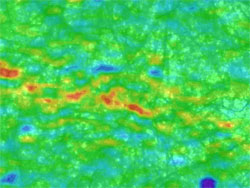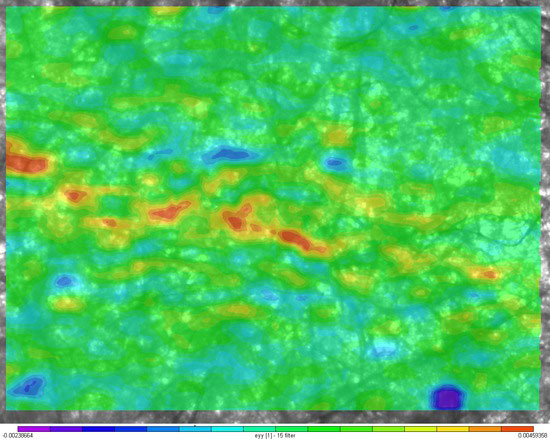Paper Stretches Unevenly
Pulling on a sheet of ordinary office paper until it tears may not seem like a very sophisticated physics experiment. But measurements reported in the 3 September Physical Review Letters show that the stretching of paper varies widely from place to place within the material and that this variation gets more important over time. The results hint at microscopic similarities in how forces deform materials as diverse as glaciers and light-bulb filaments, although the theoretical implications of the experiments remain unclear.
A wide range of materials, including metals, plastics, paper, and even rocks, distort under tensile (stretching) forces in broadly the same way. After an immediate “elastic” response, they continue to slowly deform in what is called creep, so that any two points in the material drift further apart. Typically, after a tensile force is applied, creep is relatively fast at first and then becomes progressively slower, until it begins to speed up again as a prelude to rupture.
Mikko Alava of Aalto University in Helsinki, Finland, and his colleagues wanted to measure not simply the creep in a material, but how it varies from one place to another. Such measurements, they suspected, could provide insight into the microscopic structural changes that underlie similar creep in so many different materials. As Alava points out, however, it would be hard to measure creep variations throughout a three-dimensional sample, so they decided to study ordinary sheets of copy paper.
To apply constant tension, the researchers attached a clamp across the top of a vertical sheet of paper and hung a fixed weight from another clamp on the bottom. In a series of experiments, the sheets survived from about 800 to 1600 seconds before tearing. The team took ten images per second of the sheets, which had been printed with a speckled pattern. By digitally comparing the patterns from one image to the next, the researchers deduced not only the rate at which each sheet as a whole was undergoing creep, but also how the creep varied from point to point across the surface. Overall, the creep started quickly and slowed with time in the typical way. But spatial variation in the creep slowed down less rapidly, so that relative to the overall creep, the differences from one part of the paper to another grew more pronounced with time.
“We had no idea what we would see,” Alava says. Since no one had measured the spatial variations of creep in any material before, the team compared their measured variations to those in a traditional model for creep that is used for stressed crystals. In this model, deformation is assumed to happen only at defects in the orderly crystal structure, and rigid chunks of crystalline material on either side of a defect move relative to each other. The team calculated the spatial variations expected in this model and found that they decreased more slowly than the average creep, similar to their results with paper. “It was a pleasant surprise to find the same behavior in the model and the experiment,” says Alava.
Based on the model, the team argues that the difference between overall creep and its spatial variation comes about as the populations of two types of regions vary with time– “active” regions, where deformation occurs, and “jammed” regions, where motion has become frozen. A similar transition from active to jammed states can occur in granular materials, such as sand that becomes so tightly packed that it turns effectively into an immobile mass.
Douglas Durian of the University of Pennsylvania in Philadelphia says that the measurements of creep variation are interesting, and the results fit with his own research showing that “fluctuations and unsteadiness in general grow on approach to jamming.” But he points out that in disordered materials like paper, dramatic changes in internal dynamics are not accompanied by noticeable changes in structure, in contrast to crystalline systems,. So he wonders about the correlation between the microscopic structure of the paper and the “active” and “jammed” regions posited by the authors.
–David Lindley
David Lindley is a freelance science writer in Alexandria, Virginia.





